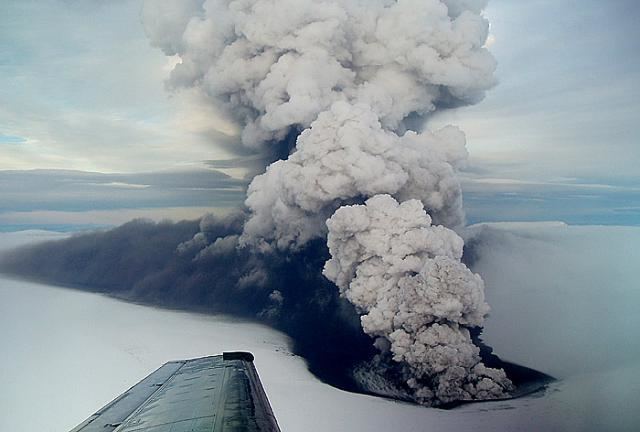Last eruption 24 May 2011 | Elevation 1,725 m | |
 | ||
Similar | ||
Grímsvötn ([ˈkrimsvœʰtn̥]; vötn = "waters", singular: vatn) is a volcano in South-East Iceland. It is in the highlands of Iceland at the northwestern side of the Vatnajökull ice-cap. The caldera is at 64°25′N 17°20′W, at an elevation of 1,725 m (5,659 ft). Beneath the caldera is the magma chamber of the Grímsvötn volcano.
Contents
- Map of GrC3ADmsvC3B6tn Iceland
- JkulhlaupEdit
- 1998 and 2004 eruptionsEdit
- 2011 eruptionEdit
- Bacteria in the subglacial lakesEdit
- Future trendsEdit
- References
Map of Gr%C3%ADmsv%C3%B6tn, Iceland
Grímsvötn is a basaltic volcano which has the highest eruption frequency of all the volcanoes in Iceland and has a southwest-northeast-trending fissure system. The massive climate-impacting Laki fissure eruption of 1783–1784 was a part of the same fissure system. Grímsvötn was erupting at the same time as Laki during 1783, but continued to erupt until 1785. Because most of the volcano lies underneath Vatnajökull, most of its eruptions have been subglacial and the interaction of magma and meltwater from the ice causes phreatomagmatic explosive activity.
On 21 May 2011 at 19:25 UTC, an eruption began, with 12 km (7 mi) high plumes accompanied by multiple earthquakes, resulting in cancellation of 900 flights in Iceland, and in the United Kingdom, Greenland, Germany, Ireland and Norway on 22–25 May. Until 25 May the eruption scale had been larger than that of the 2010 eruption of Eyjafjallajökull. The eruption stopped at 02:40 UTC on 25 May 2011, although there was some explosive activity from the tephra vents affecting only the area around the crater.
JökulhlaupEdit
Eruptions in the caldera regularly cause glacial outbursts known as jökulhlaup. Eruptions melt enough ice to fill the Grímsvötn caldera with water, and the pressure may be enough to suddenly lift the icecap, allowing huge quantities of water to escape rapidly. Consequently, the Grímsvötn caldera is monitored very carefully.
When a large eruption occurred in 1996, geologists knew well in advance that a glacial burst was imminent. It did not occur until several weeks after the eruption finished, but monitoring ensured that the Icelandic ring road (Hringvegur) was closed when the burst occurred. A section of road across the Skeiðará sandur was washed away in the ensuing flood, but no one was hurt.
1998 and 2004 eruptionsEdit
A week-long eruption occurred at Grímsvötn starting on 28 December 1998, but no glacial burst occurred. In November 2004, a week-long eruption occurred. Volcanic ash from the eruption fell as far away as mainland Europe and caused short-term disruption of airline traffic into Iceland, but again no glacial burst followed the eruption.
2011 eruptionEdit
Harmonic tremors were recorded twice around Grímsvötn on 2 and 3 October 2010, possibly indicating an impending eruption. At the same time, sudden inflation was measured by GPS in the volcano, indicating magma movement under the mountain. On 1 November 2010 meltwater from the Vatnajökull glacier was flowing into the lake, suggesting that an eruption of the underlying volcano.
On 21 May 2011 at 19:25 UTC, an eruption began, with 12 km (7 mi) high plumes accompanied by multiple earthquakes. The ash cloud from the eruption rose to 20 km (12 mi), and is so far 10 times larger than the 2004 eruption, and the strongest in Grímsvötn in the last 100 years.
Disruption to air travel in Iceland commenced on 22 May, followed by Greenland, Scotland, Norway, Svalbard and a small part of Denmark on subsequent days. On 24 May the disruption spread to Northern Ireland and to airports in northern England. The cancellation of 900 out of 90,000 European flights in the period 23–25 May was much less widespread than the 2010 disruption after the Eyjafjallajökull eruption.
Bacteria in the subglacial lakesEdit
In 2004, a community of bacteria was detected in water of the Grímsvötn lake under the glacier, the first time that bacteria have been found in a subglacial lake. The lakes never freeze because of the volcanic heat. The bacteria can also survive at low concentrations of oxygen. The site is a possible analogue for life on the planet Mars, because there are also traces of volcanism and glaciers on Mars and thus the findings could help identify how to look for life on Mars.
Future trendsEdit
Studies indicate that volcanic activity in Iceland rises and falls so that the frequency and size of eruptions in and around the Vatnajökull ice cap varies with time. It is believed that four eruptions, that have taken place in the last fifteen years, are the beginning of an active period, during which an eruption in Grímsvötn in Vatnajökull may be expected every 2–7 years. Parallel volcanic activity in nearby Bárðarbunga is known to be associated with increased activity in Grímsvötn. Seismic activity has been increasing in the area in recent years, indicating the entry of magma.
